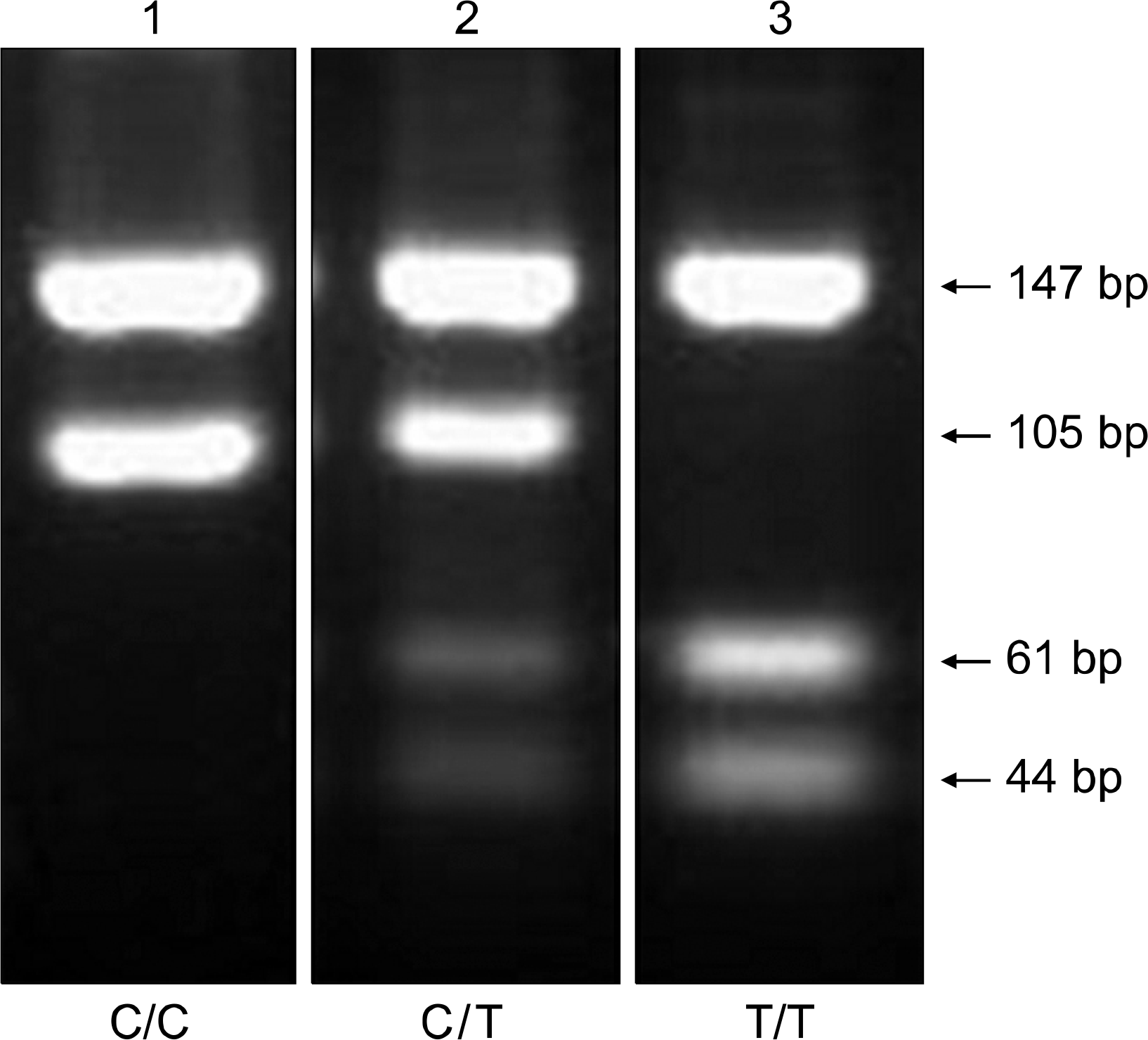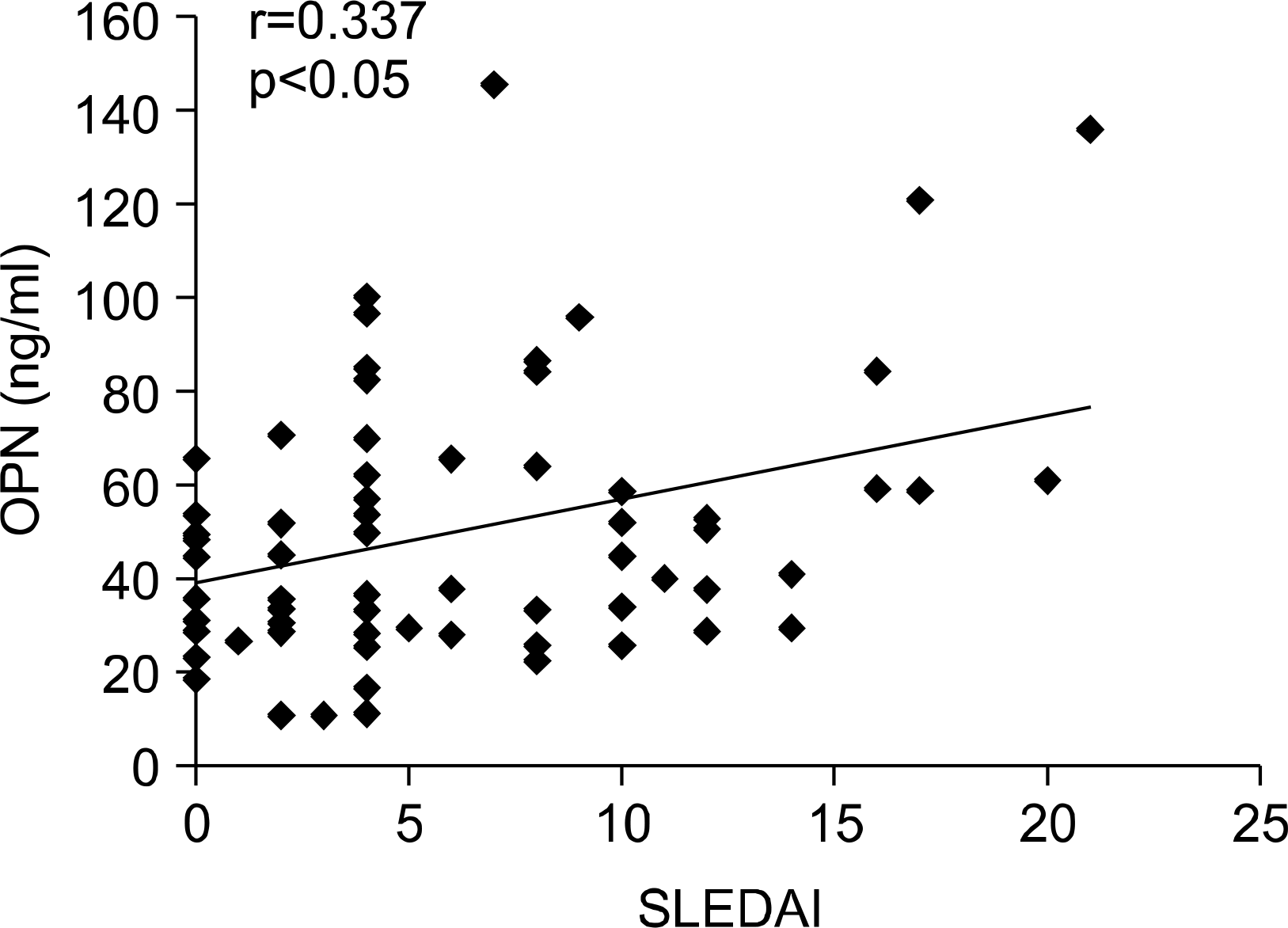Abstract
Objective
A recent study suggested that a single nucleotide polymorphism (SNP) at position nt 9250 (C to T) in exon 7 of the osteopontin (OPN) gene is strongly associated with the susceptibility to systemic lupus erythematosus (SLE). This study examined the possible association between a single nucleotide polymorphism (SNP) at position nt 9250 (C to T) and SLE and measured the serum levels of OPN in Korean patients with SLE.
Methods
A total of 39 patients with SLE and 104 healthy controls were enrolled in this study. SNP located at position 9250 in the OPN gene were genotyped using the restriction fragment length polymorphism (RFLP). The serum levels of OPN in 39 patients with SLE and 20 healthy controls were determined by enzyme-linked immunosorbent assay.
Results
The allele frequencies of C and T at this position in patients with SLE were 34.6 and 65.4, whereas those in the controls were 20.7 and 79.3 (p<0.05). The serum levels of OPN in 39 patients with SLE were significantly higher than that in 20 healthy controls (49.13±26.71 versus 28.49±18.39 ng/ml, p<0.05). The increase in OPN concentration was associated with the SLE disease activity index (SLEDAI) score in all SLE patients (r=0.337, p<0.05).
Go to : 
References
1. Weber GF, Cantor H. The immunology of Eta-1/osteopontin. Cytokine Growth Factor Rev. 1996; 7:241–8.

3. Ashkar S, Weber GF, Panoutsakopoulou V, Sanchirico ME, Jansson M, Zawaideh S, et al. Eta-1 (osteopontin): an early component of type-1 (cell-mediated) immunity. Science. 2000; 287:860–4.

4. O'Regan AW, Hayden JM, Berman JS. Osteopontin augments CD3-mediated interferon-gamma and CD40 ligand expression by T cells, which results in IL-12 prodution from peripheral blood mononuclear cells. J Leukoc Biol. 2000; 68:495–502.
5. Forton AC, Petri MA, Goldman D, Sullivan KE. An osteopontin (SPP1) polymorphism is associated with systemic lupus erythematosus. Hum Mutat. 2002; 19:459–62.

6. Xu AP, Bai J, LüJ , Liang YY, Li JG, Lai DY, et al. Osteopontin gene polymorphism in association with systemic lupus erythematosus in Chinese patients. Chin Med J. 2007; 120:2124–8.

7. D'Alfonso S, Barizzone N, Giordano M, Chiocchetti A, Magnani C, Castelli L, et al. Two single-nucleotide polymorphisms in the 5' and 3' ends of the osteopontin gene contribute to susceptibility to systemic lupus erythematosus. Arthritis Rheum. 2005; 52:539–47.
8. Bautista DS, Xuan JW, Hota C, Chambers AF, Harris JF. Inhibition of Arg-Gly-Asp (RGD)-mediated cell adhesion to osteopontin by a monoclonal antibody against osteopontin. J Biol Chem. 1994; 269:23280–5.

9. Qin LX, Tang ZY. Recent progress in predictive biomarkers for metastatic recurrence of human hepatocellular carcinoma: a review of the literature. J Cancer Res Clin Oncol. 2004; 130:497–513.

10. Vogt MH, Lopatinskaya L, Smits M, Polman CH, Nagelkerken L. Elevated osteopontin levels in active relapsing-remitting multiple sclerosis. Ann Neurol. 2003; 53:819–22.

11. Chiocchetti A, Indelicato M, Bensi T, Mesturini R, Giordano M, Sametti S, et al. High levels of osteopontin associated with polymorphisms in its gene are a risk factor for development of autoimmunity/lym-phoproliferation. Blood. 2004; 103:1376–82.

12. Masutani K, Akahoshi M, Tsuruya K, Tokumoto M, Ninomiya T, Kohsaka T, et al. Predominance of Th1 immune response in diffuse proliferative lupus nephritis. Arthritis Rheum. 2001; 44:2097–106.

13. Wong CK, Lit LC, Tam LS, Li EK, Lam CW. Elevation of plasma osteopontin concentration is correlated with disease activity in patients with systemic lupus erythematosus. Rheumatology (Oxford). 2005; 44:602–6.

14. O'Regan AW, Nau GJ, Chupp GL, Berman JS. Osteopontin (Eta-1) in cell-mediated immunity: teaching an old dog new tricks. Immunol Today. 2000; 21:475–8.
15. Xie Y, Sakatsume M, Nishi S, Narita I, Arakawa M, Gejyo F. Expression, roles, receptors, and regulation of osteopontin in the kidney. Kidney Int. 2001; 60:1645–57.

16. Iwasaki H, Shinohara Y, Ezura Y, Ishida R, Kodaira M, Kajita M, et al. Thirteen single-nucleotide polymorphisms in the human osteopontin gene identified by sequencing of the entire gene in Japanese individuals. J Hum Genet. 2001; 46:544–6.

17. Iizuka J, Katagiri Y, Tada N, Murakami M, Ikeda T, Sato M, et al. Introduction of an osteopontin gene confers the increase in B1 cell population and the production of anti-DNA autoantibodies. Lab Invest. 1998; 78:1523–33.
18. Ophascharoensuk V, Giachelli CM, Gordon K, Hughes J, Pichler R, Brown P, et al. Obstructive uropathy in the mouse: role of osteopontin in interstitial fibrosis and apoptosis. Kidney Int. 1999; 56:571–80.

Go to : 
 | Fig. 1.Representative agarose gel electrophoresis illustrating polymerase chain reaction-restriction fragment length polymorphism (PCR-RFLP) products for the Eta-1/osteopontin gene polymorphism. The nt 9250 polymorphism in exon 7: lane 1, homozygous C/C subject; lane 2, heterozygous C/T subject; lane3, homozygous T/T subject. C allele cut with Alu I generating 147- and 105-bp fragments and T allele cut with Alu I generating 61- and 44-bp fragments. |
 | Fig. 2.Correlation between serum osteopontin (OPN) level and systemic lupus erythematosus disease activity index (SLEDAI). |
Table 1.
Baseline characteristics of patients with systemic lupus erythematosus
Table 2.
Gene and allele frequencies at nt 9250 of the Eta-1/osteopontin gene in systemic lupus erythematosus patients and healthy controls
Table 3.
Difference of allele frequencies at nt 9250 of the Eta-1/osteopontin gene in SLE patients and healthy controls according to nation
Table 4.
Laboratory findings in systemic lupus erythematosus patients according to the gene variation at nucleotide 9250 on the Eta-1/osteopontin




 PDF
PDF ePub
ePub Citation
Citation Print
Print


 XML Download
XML Download